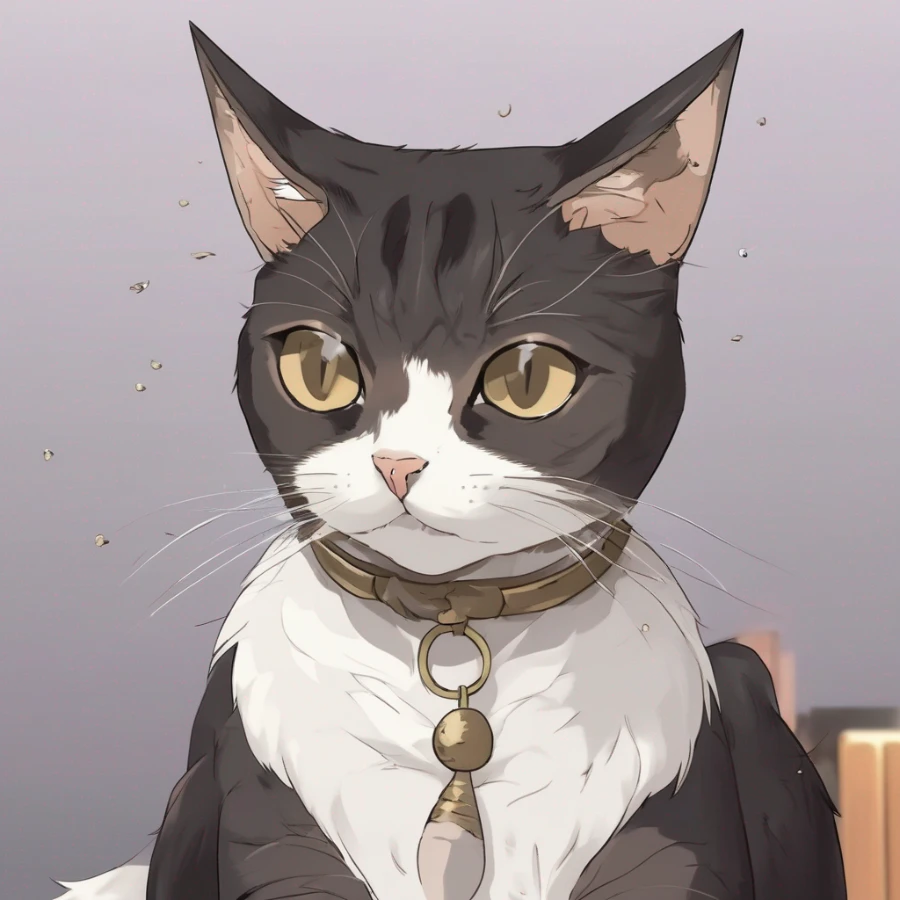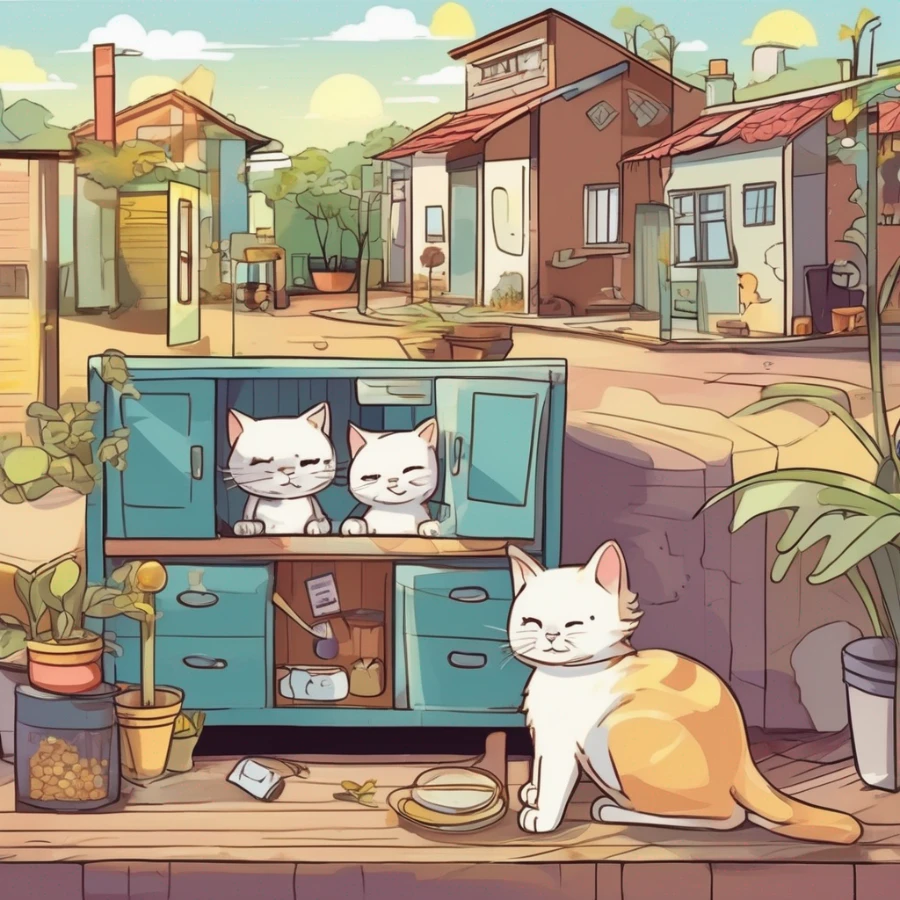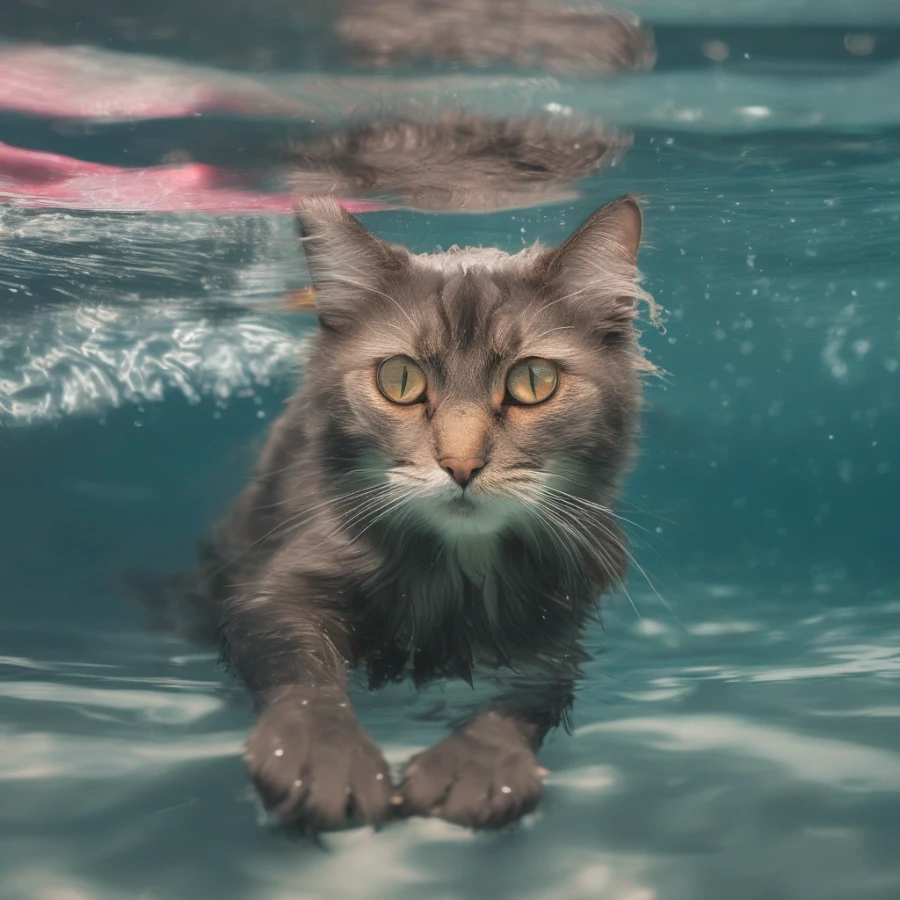Why Are Cats Scared of Cucumbers

Published by: Tatsiana Korshik
Time to Read: 10 Min
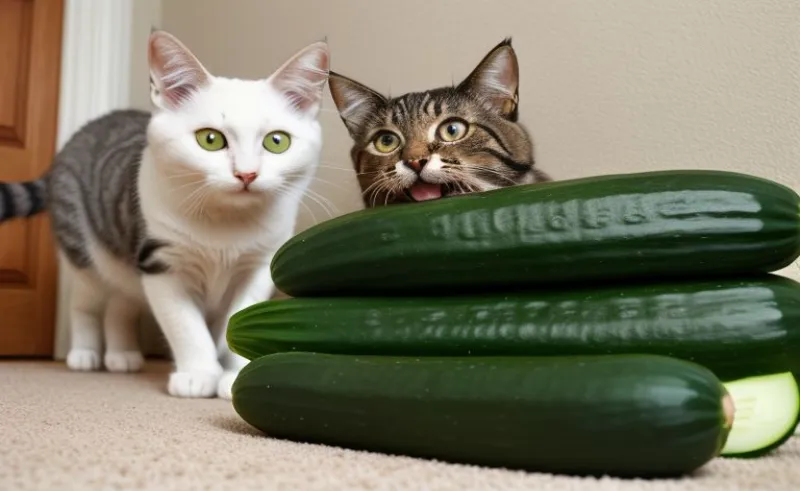
Cats, those enigmatic and often capricious companions, have baffled and amused their human counterparts for centuries. One of the more peculiar phenomena that has taken the internet by storm is the seemingly irrational fear cats exhibit when confronted with cucumbers. This peculiar reaction, characterized by startled leaps, arched backs, and wide-eyed stares, has sparked curiosity among cat owners and animal enthusiasts alike.
In this exploration, we delve into the captivating world of feline behavior, seeking to unravel the mystery behind why cats are scared of cucumbers. From dissecting the evolutionary roots of this reaction to understanding the psychological nuances at play, we embark on a journey to demystify this viral sensation. Along the way, we'll debunk myths, consider ethical implications, and offer insights into creating a safe and enriching environment for our feline friends.
Join us as we navigate through the curious realm where cats and cucumbers collide, revealing insights that extend beyond mere internet entertainment and into the intricate tapestry of the feline psyche.
1. Evolutionary Survival Instincts: Cats are hardwired with survival instincts inherited from their wild ancestors. A sudden, unexpected object resembling a snake triggers their fight-or-flight response. Cucumbers, with their elongated shape and green color, may tap into this primal instinct, causing a startled reaction.
2. Associative Learning: Cats are masters of associative learning. If a cat encounters a cucumber and experiences fear, it may form a negative association. This learned response can extend to any object with similar characteristics, contributing to the widespread fear of cucumbers among cats.
3. Disruption of Safe Space: Cats value their territory and the safety it provides. Placing an unfamiliar object, like a cucumber, in their environment disrupts their sense of security. The sudden appearance of a foreign item can trigger anxiety, leading to the characteristic startled behavior.
4. Visual Surprise Element: Cucumbers are often introduced quietly behind a cat while it's engrossed in eating or grooming. The element of surprise enhances the cat's reaction. The sudden juxtaposition of an unexpected object amplifies the fear response.
5. Individual Variations: Not all cats react the same way to cucumbers. While some may exhibit dramatic responses, others might remain indifferent. Factors like age, personality, and past experiences play a role in determining a cat's reaction to the cucumber phenomenon.
Understanding these facets of feline behavior sheds light on the seemingly bizarre reaction to cucumbers. As a cat owner, recognizing and respecting these instincts contributes to creating a harmonious and stress-free environment for your feline companion.
In the world of feline behavior, distinguishing between a startled response and genuine fear is crucial. Cats, by nature, are highly alert and can be easily surprised. Understanding the nuances of their reactions helps unravel the intricacies of the fear factor associated with cucumbers.
Startled Response: Cats are naturally cautious creatures, and a sudden, unexpected stimulus can trigger a startled response. This reaction is often characterized by a swift jump, arched back, and dilated pupils. It's a momentary response to perceived danger, with the cat quickly assessing the situation.
Genuine Fear: True fear in cats involves a more sustained and intense reaction. A genuinely frightened cat may exhibit defensive behaviors such as hissing, growling, or attempting to flee. Identifying these signs is essential for responsible pet ownership, as it indicates a higher level of distress that requires attention and intervention.
To comprehend why cats react strongly to cucumbers, it's crucial to delve into how they perceive these unfamiliar objects. Cats rely heavily on their senses, particularly vision and smell, to interpret their surroundings. Cucumbers, resembling snakes in shape and color, tap into the feline instinct to stay vigilant against potential threats.
Visual Perception: Cats are highly visual animals, and the sudden appearance of a cucumber can be visually startling. The elongated shape and contrasting color against the backdrop of familiar surroundings contribute to the cat's heightened reaction.
Sensory Dissonance: The clash between the cat's expectation of its environment and the sudden presence of an unfamiliar object creates sensory dissonance. This disorientation intensifies the cat's reaction, as it tries to make sense of the incongruity.
While the cucumber phenomenon has gained widespread attention, it's essential to acknowledge the diversity in feline reactions. Not every cat responds with fear, and variations in age, temperament, and past experiences influence how each cat perceives and reacts to cucumbers or similar unexpected objects.
Age and Experience: Kittens, for instance, may exhibit more curiosity than fear, while older cats might be more cautious. Positive or negative past experiences with unexpected stimuli also shape a cat's subsequent reactions.
Personality Traits: A cat's individual personality plays a significant role. Some cats may be naturally more skittish, while others remain unfazed by sudden changes in their environment.
Exploring these variations adds depth to our understanding of feline behavior, emphasizing the importance of treating each cat as an individual with unique sensitivities and responses.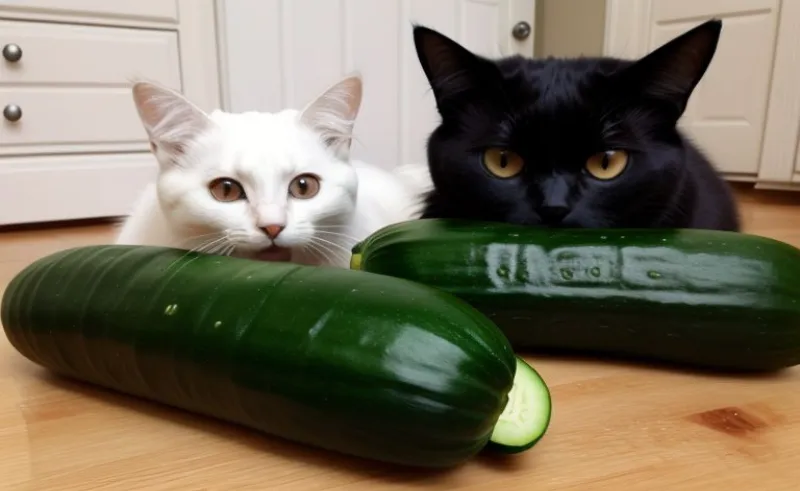
When it comes to amusing ourselves at our pets' expense, it's important to consider the ethics behind the viral trend of scaring cats with cucumbers. While the internet revels in the entertaining reactions of felines, the impact on their well-being should not be overlooked.
Understanding Stress in Cats: Cats, known for their keen senses and independent nature, can experience stress that goes beyond a momentary fright. Chronic stress in cats has been linked to various health issues, emphasizing the need to prioritize their emotional well-being.
The Potential for Trauma: Repeated exposure to startling situations can lead to lasting trauma in cats. Trust, a crucial element in the human-feline bond, can erode, affecting the overall quality of the relationship. Responsible pet ownership entails safeguarding your cat's mental health.
Alternatives to Pranks: Rather than resorting to potentially distressing pranks, consider engaging your cat in ways that enrich their lives positively. Interactive toys, puzzle feeders, and play sessions tailored to their preferences provide entertainment without compromising their well-being.
Fostering a secure and stress-free environment is a cornerstone of responsible pet ownership, especially for our feline companions who thrive on stability.
Providing Safe Havens: Every home should offer designated safe spots where your cat can retreat when feeling overwhelmed. These hideaways provide a sense of security and control, contributing to a more relaxed and contented cat.
Consistent Routine Matters: Cats appreciate routine and predictability. Establishing consistent feeding times, play sessions, and quiet periods helps create an environment that minimizes stress and contributes to your cat's overall happiness.
Enrichment for a Happy Cat: Stimulating your cat's mind and body is essential. Invest in toys that encourage natural behaviors, scratching posts to satisfy their instinct to claw, and window perches to offer mental stimulation through observing the outside world.
Building a positive relationship with your cat involves recognizing and respecting their boundaries. Paying attention to their cues and responding appropriately is key to a harmonious coexistence.
Reading Body Language: Observing your cat's body language is crucial in understanding their comfort level. Positive signs like purring and relaxed postures indicate contentment, while signs of discomfort such as hissing or flattened ears should be respected.
Introducing Changes Gradually: Whether it's a new object or a change in the environment, introduce alterations gradually. This approach allows your cat to acclimate without feeling threatened, reducing the likelihood of fear responses.
Positive Reinforcement Matters: Rewarding positive behaviors with treats and affection reinforces trust. Avoid punishing fearful reactions, as this can intensify anxiety and hinder the development of a positive relationship.
By considering the ethics of using cucumbers for entertainment, creating a secure environment, and respecting your cat's boundaries, you actively contribute to the well-being of your feline friend. Responsible pet ownership is a commitment to ensuring that your cat feels safe, loved, and content in their home.
In this exploration, we delve into the captivating world of feline behavior, seeking to unravel the mystery behind why cats are scared of cucumbers. From dissecting the evolutionary roots of this reaction to understanding the psychological nuances at play, we embark on a journey to demystify this viral sensation. Along the way, we'll debunk myths, consider ethical implications, and offer insights into creating a safe and enriching environment for our feline friends.
Join us as we navigate through the curious realm where cats and cucumbers collide, revealing insights that extend beyond mere internet entertainment and into the intricate tapestry of the feline psyche.
The Phenomenon of Cucumber Fear
If you've ever chuckled at the viral videos of cats leaping at the sight of a cucumber, you're not alone. The phenomenon of cats being scared of cucumbers has intrigued cat owners and animal behaviorists alike. Let's dig into the reasons behind this peculiar reaction.1. Evolutionary Survival Instincts: Cats are hardwired with survival instincts inherited from their wild ancestors. A sudden, unexpected object resembling a snake triggers their fight-or-flight response. Cucumbers, with their elongated shape and green color, may tap into this primal instinct, causing a startled reaction.
2. Associative Learning: Cats are masters of associative learning. If a cat encounters a cucumber and experiences fear, it may form a negative association. This learned response can extend to any object with similar characteristics, contributing to the widespread fear of cucumbers among cats.
3. Disruption of Safe Space: Cats value their territory and the safety it provides. Placing an unfamiliar object, like a cucumber, in their environment disrupts their sense of security. The sudden appearance of a foreign item can trigger anxiety, leading to the characteristic startled behavior.
4. Visual Surprise Element: Cucumbers are often introduced quietly behind a cat while it's engrossed in eating or grooming. The element of surprise enhances the cat's reaction. The sudden juxtaposition of an unexpected object amplifies the fear response.
5. Individual Variations: Not all cats react the same way to cucumbers. While some may exhibit dramatic responses, others might remain indifferent. Factors like age, personality, and past experiences play a role in determining a cat's reaction to the cucumber phenomenon.
Understanding these facets of feline behavior sheds light on the seemingly bizarre reaction to cucumbers. As a cat owner, recognizing and respecting these instincts contributes to creating a harmonious and stress-free environment for your feline companion.
The Psychology of Cat Reactions
Startling vs. Scaring: Unraveling the Fear Factor
In the world of feline behavior, distinguishing between a startled response and genuine fear is crucial. Cats, by nature, are highly alert and can be easily surprised. Understanding the nuances of their reactions helps unravel the intricacies of the fear factor associated with cucumbers.
Startled Response: Cats are naturally cautious creatures, and a sudden, unexpected stimulus can trigger a startled response. This reaction is often characterized by a swift jump, arched back, and dilated pupils. It's a momentary response to perceived danger, with the cat quickly assessing the situation.
Genuine Fear: True fear in cats involves a more sustained and intense reaction. A genuinely frightened cat may exhibit defensive behaviors such as hissing, growling, or attempting to flee. Identifying these signs is essential for responsible pet ownership, as it indicates a higher level of distress that requires attention and intervention.
Cat vs. Cucumber: A Clash of Perceptions
To comprehend why cats react strongly to cucumbers, it's crucial to delve into how they perceive these unfamiliar objects. Cats rely heavily on their senses, particularly vision and smell, to interpret their surroundings. Cucumbers, resembling snakes in shape and color, tap into the feline instinct to stay vigilant against potential threats.
Visual Perception: Cats are highly visual animals, and the sudden appearance of a cucumber can be visually startling. The elongated shape and contrasting color against the backdrop of familiar surroundings contribute to the cat's heightened reaction.
Sensory Dissonance: The clash between the cat's expectation of its environment and the sudden presence of an unfamiliar object creates sensory dissonance. This disorientation intensifies the cat's reaction, as it tries to make sense of the incongruity.
Individual Variations: Not Every Cat is Scared
While the cucumber phenomenon has gained widespread attention, it's essential to acknowledge the diversity in feline reactions. Not every cat responds with fear, and variations in age, temperament, and past experiences influence how each cat perceives and reacts to cucumbers or similar unexpected objects.
Age and Experience: Kittens, for instance, may exhibit more curiosity than fear, while older cats might be more cautious. Positive or negative past experiences with unexpected stimuli also shape a cat's subsequent reactions.
Personality Traits: A cat's individual personality plays a significant role. Some cats may be naturally more skittish, while others remain unfazed by sudden changes in their environment.
Exploring these variations adds depth to our understanding of feline behavior, emphasizing the importance of treating each cat as an individual with unique sensitivities and responses.
Ethical Considerations and Responsible Pet Ownership

Playing Pranks: Harmless Fun or Animal Cruelty?
When it comes to amusing ourselves at our pets' expense, it's important to consider the ethics behind the viral trend of scaring cats with cucumbers. While the internet revels in the entertaining reactions of felines, the impact on their well-being should not be overlooked.
Understanding Stress in Cats: Cats, known for their keen senses and independent nature, can experience stress that goes beyond a momentary fright. Chronic stress in cats has been linked to various health issues, emphasizing the need to prioritize their emotional well-being.
The Potential for Trauma: Repeated exposure to startling situations can lead to lasting trauma in cats. Trust, a crucial element in the human-feline bond, can erode, affecting the overall quality of the relationship. Responsible pet ownership entails safeguarding your cat's mental health.
Alternatives to Pranks: Rather than resorting to potentially distressing pranks, consider engaging your cat in ways that enrich their lives positively. Interactive toys, puzzle feeders, and play sessions tailored to their preferences provide entertainment without compromising their well-being.
Creating a Safe Environment for Your Cat
Fostering a secure and stress-free environment is a cornerstone of responsible pet ownership, especially for our feline companions who thrive on stability.
Providing Safe Havens: Every home should offer designated safe spots where your cat can retreat when feeling overwhelmed. These hideaways provide a sense of security and control, contributing to a more relaxed and contented cat.
Consistent Routine Matters: Cats appreciate routine and predictability. Establishing consistent feeding times, play sessions, and quiet periods helps create an environment that minimizes stress and contributes to your cat's overall happiness.
Enrichment for a Happy Cat: Stimulating your cat's mind and body is essential. Invest in toys that encourage natural behaviors, scratching posts to satisfy their instinct to claw, and window perches to offer mental stimulation through observing the outside world.
Understanding Boundaries: Respecting Your Cat's Comfort Zone
Building a positive relationship with your cat involves recognizing and respecting their boundaries. Paying attention to their cues and responding appropriately is key to a harmonious coexistence.
Reading Body Language: Observing your cat's body language is crucial in understanding their comfort level. Positive signs like purring and relaxed postures indicate contentment, while signs of discomfort such as hissing or flattened ears should be respected.
Introducing Changes Gradually: Whether it's a new object or a change in the environment, introduce alterations gradually. This approach allows your cat to acclimate without feeling threatened, reducing the likelihood of fear responses.
Positive Reinforcement Matters: Rewarding positive behaviors with treats and affection reinforces trust. Avoid punishing fearful reactions, as this can intensify anxiety and hinder the development of a positive relationship.
By considering the ethics of using cucumbers for entertainment, creating a secure environment, and respecting your cat's boundaries, you actively contribute to the well-being of your feline friend. Responsible pet ownership is a commitment to ensuring that your cat feels safe, loved, and content in their home.

